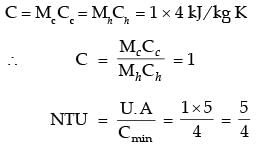Past Year Questions: Heat Exchanger - Mechanical Engineering MCQ
20 Questions MCQ Test Additional Study Material for Mechanical Engineering - Past Year Questions: Heat Exchanger
In shell and tube heat exchanger, baffles are mainly used to
[1991]
The practice to use steam on the shell side and water on the tube side in condensers of steam power plant is because
[1994]
| 1 Crore+ students have signed up on EduRev. Have you? Download the App |
Hot oil is cooled from 80 to 50°C in an oil cooler which uses air as the coolant. The air temperature rises from 30 to 40°C. The designer uses a LMTD value of 26°C. The type of heat exchanger is
[2005]
In a heat exchanger, it is observed that ΔT1 = ΔT2 where ΔT1 is the temperature difference between the two single phase fluid streams at one end and ΔT2 is the temperature difference at the other end. This heat exchanger is
[2014]
In certain heat exchanger, both the fluids have identical mass flow rate specific heat product. The hot fluid enters at 76°C and leaves at 47°C, and the cold fluid entering at 28°C leave at 55°C, the effectiveness of the HE is
[1997]
In a counter flow heat exchanger, for the hot fluid the heat capacity = 2 kJ/kgK, mass flow rate = 5 kg/s, inlet temperature = 150°C, outlet temperature = 100°C. For the cold fluid, heat capacity = 4 kJ/kg K, mass flow rate = 10 kg/s, inlet temperature = 20°C. Neglecting heat transfer to the surroundings, the outlet temperature of the cold fluid in °C is
[1994]
In a condenser, water enters at 30°C and flows at the rate 1500 kg/hr. The condensing steam is at a temperature of 120°C and cooling water leaves the condenser at 80°C. Specific heat of water is 4.187 kJ/kgK. If the overall heat transfer coefficient is 2000 W/m2K, the heat transfer area is
[2005]
An industrial gas (c = 1 kJ/kgK) enters a parallel flow heat exchanger at 250°C with a flow rate of 2 kg/s to heat a water stream. The water stream (c = 4 kJ/kgK) enters the heat exchanger at 50°C with a flow rate of 1 kg/s.The heat exchanger has an effectiveness of 0.75. The gas stream exit temperature will be
[2010]
Cold water flowing at 0.1 kg/s is heated from 20°C to 70°C in a counter flow type heat exchanger by a hot water stream flowing at 0.1 kg/s and entering at 90°C. The specific heat of water is 4200 J/(kgK) and density is 1000 kg/m3. If the overall heat transfer coefficient U for the heat exchanger is 2000 W/(m2K), the required heat exchange area (in m2) is
[2011]
A balanced counter flow heat exchanger has a surface area of 20 m2 and overall heat transfer coefficient of 20 W/m2K. Air (cp = 1000 J/kgK) entering at 0.4 kg/s and 280 K is to be preheated by the air leaving the system at 0.4 kg/s and 300 K. The temperature (in K) of the preheated air is
[2015]
In a counter-flow heat exchanger, water is heated at the rate of 1.5 kg/s from 40°C to 80°C by an oil entering at 120°C and leaving at 60°C. The specific heats of water and oil are 4.2 kJ/ kgK and 2 kJ/kgK, respectively. The overall heat transfer coefficient is 400 W/m2K.The required heat transfer surface area (in m2) is
[2007]
Air enters a counter flow HE at 70°C and leaves at 40°C. Water enters at 30°C and leaves at 50°C, the LMTD in degree C is
[2000]
For the same inlet and exit temperatures of the hot and cold fluids, the log mean temperature difference (LMTD) is
[2002]
In a counterflow heat exchanger, hot fluid enters at 60°C and cold fluid leaves at 30°C. Mass flow rate of the hot fluid is 1 kg/s and that the cold fluid is 2 kg/s. Specific heat of the hot fluid is 10 kJ/kgK and that of the cold fluid is 5 kJ/kgK. The Log Mean Temperature Difference (LMTD) for the heat exchanger in °C is
[2007]
The logarithmic mean temperature difference (LMTD) of a counter flow heat exchanger is 20°C. The cold fluid enters at 20°C and the hot fluid enters at 100°C. Mass flow rate of the cold fluid is twice that of the hot fluid. Specific heat at constant pressure of the hot fluid is twice that of the cold fluid. The exit temperature of the cold fluid
[2008]
In a condenser of a power plant, the steam condenses at a temperature of 60°C. The cooling water enters at 30°C and leaves at 45°C. The Logarithmic Mean Temperature Difference (LMTD) of the condenser is
[2011]
Water (c = 4.18 kJ/kgK) at 80°C enters a counter flow heat exchanger with a mass flow rate of 0.5 kg/s. Air (c = 1 kJ/kgK) enter at 30°C with a mass flow rate 2.09 kg/s. If the effectiveness of the heat exchanger is 0.8, the LMTD (in °C) is
[2012]
For a heat exchanger, ΔTmax is the maximum temperature difference and ΔTmin is the minimum temperature difference between the two fluids. LMTD is the log mean temperature difference. Cmin and Cmax are the minimum and the maximum heat capacity rates. The maximum possible heat transfer (Qmax) between the two fluids is
[2014]
In a parallel flow heat exchanger operating under steady state, the heat capacity rates (product of specific heat at constant pressure and mass flow rate) of the hot and cold fluid are equal. The hot fluid, flowing at 1 kg/s with cp = 4 kJ/kgK, enters the heat exchanger at 102°C while the cold fluid has an inlet temperature of 15°C. The overall heat transfer coefficient for the heat exchanger is estimated to be 1 kW/m2K and the corresponding heat transfer surface area is 5 m2. Neglect heat transfer between the heat exchanger and the ambient. The heat exchanger is characterized by the following relation:
2ε = 1 - expt(-2NTU). The exit temperature (in °C) for the cold fluid is
[2009]
Saturated vapor is condensed to saturated liquid in a condenser. The heat capacity ratio is  The effectiveness (e) of the condenser is
The effectiveness (e) of the condenser is
[2015]
|
1 videos|30 docs|57 tests
|
|
1 videos|30 docs|57 tests
|








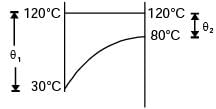



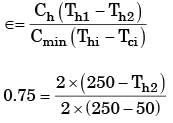


 Temperature Tci = 280K
Temperature Tci = 280K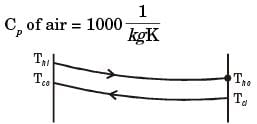


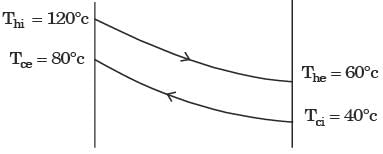
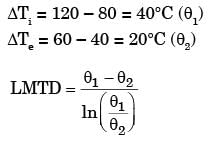

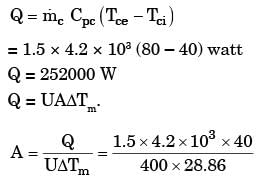
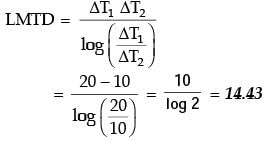

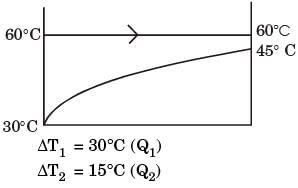





 .
.




